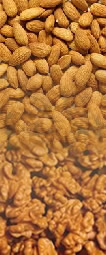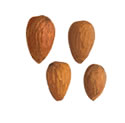


 | ||||
About Almonds
Almonds are California's largest tree nut crop in total dollar value and acreage. They rank as the largest U.S. horticultural export. Approximately 6,000 almond growers produce nearly 100 percent of the commercial domestic supply and more than 75 percent of worldwide production. Nearly 80 countries import California almonds. The United States is by far the largest market for almonds, overseas, Germany is the largest market for almonds, consuming about 16 percent of the export crop, followed by Spain at about 15 percent. Other major importers include the Netherlands, Japan, France, the United Kingdom, Canada, India, China and Spain. The Pacific Rim nations are a rapidly growing market for California almonds
Nutrition Facts
News Links
Almond History
California Almond Varieties
Almond Grades and Tolerances
The tasty almond delivers not only flavor and texture to everything it’s added to, but also more complete nutrition than you can imagine in just one handful. For the most copmprehensive, up to date information on all the health benefits of almonds, check out Almonds are In!
Among other benefits, almonds are high in vitamin E, an antioxidant that defends your cells against damage on a daily basis. Scientific studies suggest that vitamin E may prove to be even more beneficial in years to come. Preliminary research points to the promising effects of vitamin E in curbing certain chronic diseases. To learn more check out Get Your E.Org.
Almonds are mentioned as far back in history as the Bible. They were a prized ingredient in breads served to Egypt's pharos. Their exact ancestry in unknown, but almonds are thought to have originated in China and Central Asia.
Explorers ate almonds while traveling the "Silk Road" between Asia and the Mediterranean. Before long, almond trees flourished in the Mediterranean -- especially in Spain and Italy.
The almond tree was brought to California from Spain in the mid-1700's by the Franciscan Padres. The moist, cool weather of the coastal missions, however, did not provide optimum growing conditions. It wasn't until the following century that trees were successfully planted inland. By the 1870's, research and cross-breeding had developed several of today's prominent almond varieties. By the turn of the 20th century, the almond industry was firmly established in the Sacramento and San Joaquin areas of California's great Central Valley.
Throughout history, almonds have maintained religious, ethnic and social significance. The Bible's "Book of Numbers" tells the story of Aaron's rod that blossomed and bore almonds, giving the almond the symbolism of divine approval.
The Romans showered newlyweds with almonds as a fertility charm. Today, Americans give guests at weddings a bag of sugared almonds, representing children, happiness, romance, good health and fortune. In Sweden, cinnamon-flavored rice pudding with an almond hidden inside is a Christmas custom. Find it, and good fortune is yours for a year.
Soure: Almond Board of California
Several almond variety types are specified by the industry for marketing purposes. Of the four major marketing groups listed here, about 90 percent of the almond production falls into the categories of Nonpareil, California and Mission.
Nonpareil Type
With the widest range of uses among the marketing categories, Nonpareils are readily blanched and cut for processed forms. A thin outer shell and smooth kernel allow for easy, blemish-free processing. As a result, Nonpareils are used anywhere an attractive appearance or strong almond ID is important.
Mission and Mission Types
Mission variety almonds have a thick, stout shell and wrinkled kernel. The skin of a Mission almond has a deep brownish-red hue, darker than the Nonpareil. The kernels are also wider than the Nonpareil and have a stronger flavor. Though the Mission's deep wrinkles render it unsuitable for blanching, they help the nut hold seasonings and adhere to other foods, and are perfect for use in snack mixes and ice creams. Their robust flavor is especially enhanced by roasting.
California Type
This classification includes a number of varieties, all of which are blanchable, and used primarily in manufactured products. California shells are of medium thickness, and their skins have a color that is slightly darker than the Nonpareil. As a result, the California variety is quite adaptable, and well suited for nearly any process or application.
Carmel Type
Actually a member of the California type varieties, the Carmel has become popular enough to warrant its own classification. A soft-shell variety, Carmel almonds are often used for blanching and roasting. Because they are easily processed, Carmel types are often substituted for both Nonpariel and California.
Effective March 24, 1997
For information only. For a complete copy of the grades contact the Almond Board of California at (209) 549-8262.
U.S.D.A. 
 Select Standard #1 Whole &
Select Standard #1 Whole &
Grades 
 Fancy Extra #1 U.S. #1 Sheller Run Sheller Run Broken #1 Pieces
Fancy Extra #1 U.S. #1 Sheller Run Sheller Run Broken #1 Pieces
Whole Kernels -
- -
- -
- -
- -
- 30%
30% X
X
Min. Diameter in Inch - -
- -
- -
- -
- 20/64, UOS
20/64, UOS 8/64
8/64
Dissimilar 5%
5% 5%
5% 5%
5% 5%
5% 5%
5% 5%
5% X
X
Doubles 3%
3% 5%
5% 15%
15% 15%
15% 25%
25% 35%
35% X
X
Chip & Scratch 5%
5% 5%
5% 10%
10% 20%
20% 35%
35% X
X X
X
Foreign Material .05%
.05% .05% .05%
.05% .05% .1%
.1% .2%
.2% .2%
.2% .2%
.2%
Particles & Dust .1%
.1% .1%
.1% .1%
.1% .1%
.1% .1%
.1% .1%
.1% 1%
1%
Split & Broken 1%
1% 1%
1% 1%
1% 5%
5% 15%
15% X
X X
X
Other Defects 2%
2% 4%
4% 5%
5% 3%
3% 3%
3% 5%
5% 5%
5%
Serious Defects 1%
1% 1.5% 1.5%
1.5% 1.5% 2%
2% 2%
2% 3%
3% 3%
3%
Under-size -
- -
- -
- -
- -
- 5%
5% 5%
5%
• Whole Kernels: Less than 1/8 kernel chipped off.
Whole Kernels: Less than 1/8 kernel chipped off.
• Chip & Scratch: More than 1/4 inch in diameter except U.S. Fancy with 1/8 inch in diameter.
Chip & Scratch: More than 1/4 inch in diameter except U.S. Fancy with 1/8 inch in diameter.
• Split & Broken: 7/8 or less of complete whole kernel at least 1/8 inch in diameter.
Split & Broken: 7/8 or less of complete whole kernel at least 1/8 inch in diameter.
• Serious Defects: Includes decay, rancidity, insect injury and damage by mold.
Serious Defects: Includes decay, rancidity, insect injury and damage by mold.
• Insect: Insect, web, or frass present or definite evidence of feeding.
Insect: Insect, web, or frass present or definite evidence of feeding.
• X: No limit established
X: No limit established
Also included in "Other Defects".
• : Includes max. 2% under 20/64
: Includes max. 2% under 20/64
• : Includes max. 5% under 20/64 inch. % also included in "Chip & Scratch".
: Includes max. 5% under 20/64 inch. % also included in "Chip & Scratch".
Other Defects:
• Gum: More than 1/4 inch in diameter.
Gum: More than 1/4 inch in diameter.
• Shriveling: Less than 3/4 of pellicle filled.
Shriveling: Less than 3/4 of pellicle filled.
• Brown Spot: More than 1/8 inch in diameter.
Brown Spot: More than 1/8 inch in diameter.
• Discoloration: More than 1/2 of surface.
Discoloration: More than 1/2 of surface.


